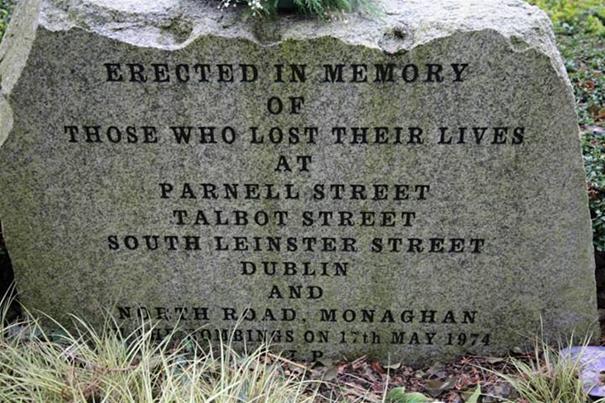
Today in Irish History: 1974 It may surprise many that the greatest number of civilian casualties in terrorist bombings in Ireland during the “Troubles” in the 70’s and 80’s occurred not in Northern Ireland but in the Republic. The Dublin and Monaghan bombings of 17 May 1974 were a series of car bombings in Dublin and Monaghan in the Republic of Ireland. The attacks killed 33 civilians and wounded almost 300, the highest number of casualties in any one day during The Troubles. At 17:30 on Friday 17 May 1974, without prior warning, three car bombs exploded almost simultaneously in Dublin's city centre at Parnell Street, Talbot Street, and South Leinster Street by the wall of Trinity College during the evening rush hour. The locations of the bombs in three busy streets at rush hour over a half mile of Dublin’s City Centre were designed both to maximise panic and casualties. They were constructed so well that one hundred per cent of each bomb exploded upon detonation. Twenty three people died in these explosions and three others died as a result of injuries over the following few days and weeks. Many of the dead were young women originally from rural Irish towns employed in the civil service. An entire family from central Dublin was killed. Two of the victims were foreign nationals: an Italian man, and a French Jewish woman whose family had survived the Holocaust. Most of the bodies were blasted beyond recognition, including one which was decapitated. There were approximately 300 people injured, many of them horrifically mutilated. Most of the victims were young women, although the ages of the dead ranged from 5 months to 80 years. 15 year old Derek Byrne regained consciousness at the morgue where he had been pronounced dead. “I was just lying on the table. It was full of bodies. I just let out a scream. The mortuary attendant then let out a scream.” A number of official reports suggest that the bombers had support from members of the British forces in Northern Ireland. The Barron Report quotes the then Secretary of State for Northern Ireland Mr. Merlyn Rees, in relation to a subversive faction in the British Army: ‘ It was a unit, a section out of control. There is no doubt it reflected the views of a number of soldiers.’ “ Let’s go in and fix this lot’’, and so on. At the time of the bombings Northern Ireland was virtually at a standstill in a strike organised by The Ulster’s Workers Council (UWC) in protest at the Sunningdale Agreement between the British and Irish Governments. In Northern Ireland, Sammy Smyth, then press officer of both the Ulster Defence Association (UDA) and the Ulster Workers' Council (UWC) Strike Committee, said: “I am very happy about the bombings in Dublin. There is a war with the Free State and now we are laughing at them” The Garda Siochana and Irish Government have been criticized about events following the bombing. Some early strong evidence was not pursued; evidence disappeared including a car registration plate with a fingerprint of one of the suspected bombers. Barron reported: “The Garda investigation failed to make full use of the information it obtained. Certain lines of inquiry that could have been pursued further in this jurisdiction were not pursued” The Irish Government reaction in trying to find the killers has been criticized as been lack luster and uninterested. This may have been a deliberate decision due to the incredibly high tensions of the time. Had the involvement of British security forces become public knowledge, it would have caused an absolute firestorm of emotion and almost certainly even further substantial violence. Footage -https://www.youtube.com/watch?v=BIuyuPsy0Mo



